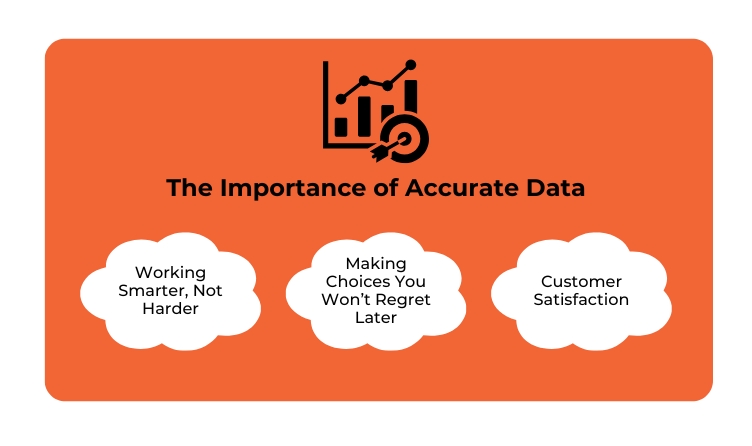Steps to Ensure Accurate Customer Data for Your Business
5 Mins Read
Published on: 25 May 2023
Last Updated on: 21 November 2024

toc impalement
Greetings, fellow data geeks! Are you tired of playing a game of dodgeball with inaccurate business data? However, this article on customer data management can change the whole deal.
Making wild guesses about your customers’ behavior is so last century. As a result, now we have the customer data management tools and strategies to analyze and predict how your customers will act.
Businesses continually strive to collect relevant and accurate data to help them make more informed decisions. Hence, they do this by using web analytics and customer data. However, ensuring the accuracy of this data is also crucial, as incorrect information can become the potential downfall of a company.
Therefore, in this blog post, we will discuss what can a business do to ensure data is correct in just five steps. Follow along.
The Importance of Accurate Data

Every business needs to understand how important accurate data is. As a result, it’s the backbone of intelligent decision-making, growth, and keeping ahead of the market.
These are a few examples of why correct data is valuable.
Working Smarter, Not Harder
When the information is correct, you can improve your business by coordinating it. Hence, from managing supplies to distributing resources, accurate data allows you to enhance methods and reduce costs.
Making Choices You Won’t Regret Later
Accurate data allows the management to make judgments based on facts rather than theories. Therefore, this means that strategies are more likely to work, increasing the chance of a successful outcome.
Customer Satisfaction
With accurate information, you can learn more about your customers. Additionally, you can personalize experiences, offer specialized coupons, and develop lasting connections. Everything with the help of exact records of their tastes, purchases, and behavior.
Step-By-Step Guide to Customer Data Management
Now that we know how vital data accuracy is, here are five steps to ensure you collect the correct data. Therefore, try to follow this guide to learn more about the subject.
Step 1: Use Reliable Data Validation Methods

Confirmation is the key to getting the correct info. Here’s how to set up a reliable system for verifying data.
Check at Every Step
Ensure data is checked and confirmed at different stages, such as entering, moving, or combining. Therefore, this helps find mistakes early and stop them from spreading. Hence, a simple cross-check can go a long way to validate data accuracy.
Use Tools That Run Themselves
Use software and programs to find and fix mistakes quickly. Moreover, these applications can check for errors, missing numbers, and exceptions, reducing much work. For instance, you can use a phone validator to confirm the authenticity of a specific caller ID.
Clean Up Your Data
Clean your data regularly to eliminate duplicates, gaps, or expired facts. Moreover, data cleaning ensures that your files are compact, correct, and don’t have any inaccuracies.
Step 2: Create Data Management Standards
Data control is crucial if you want your organization to be running smoothly. Here’s how to create explicit data control guidelines:
Responsibility and Tasks
Ensure everyone in your organization knows who owns the data and their roles and duties. Therefore, when you divide up the responsibility of maintaining accurate data among different departments or teams, it is more likely the data collected will be precise.
Optimize Managing Data
Adopt data management systems prioritizing data quality, safety inspections, and privacy policies. Hence, the way data management is done is guided by these models.
Make Sure Things Are the Same
Ensure that data entry, description methods, and style all follow the same rules and structures. Therefore, similar information types prevent mistakes and make it easier for systems to work together.
Step 3: Improve Tracking and Analysis
Invest in intelligent tracking tools and algorithms to ensure your data is correct. Here’s what it can do for you.
Real-Time Tracking
Set up tracking tools that monitor the accuracy of data in real time. Therefore, when data mistakes and errors are found, these platforms send messages and emails to notify the issue.
Use Statistical Information
Set up analytical tools to find patterns, trends, and exceptions in your data. Therefore, you can find likely errors and fix them quickly by looking at big data sets.
Early Error Detection
Set up ways for your data tools to find errors before they happen. Additionally, this lets you find mistakes and fix them before they affect how you make decisions or run your business.
Step 4: Train and Develop Your Staff

Your team is a vital part of ensuring the information collected is correct. Here are a few suggestions for teaching and training them.
Thorough Training
Teach them everything they need about data entry, direction, and monitoring quality. Hence, ensure your team has the skills and information they need to handle data correctly.
Create a Data-Driven Mindset
Make sure your organization has a data-driven attitude. Push workers to put data accuracy first, share their ideas, and act on actions that use correct data. Moreover, train your employees to gather more information from customers effectively.
Constant Growth
Push employees to keep learning and getting better at how they handle data. Moreover, keep up with recent data management methods, ideas, and strategies. Subsequently, pass on the knowledge or train your employees on
Step 5: Standard Reviews and Checks
Data accuracy can be built up over time with the help of regular checks and feedback. Here’s how to put them into action effectively:
Frequent Surveys
Perform regular checkups to ensure data accuracy and identify ways to improve it. As a result, reviews help you find hidden flaws and ensure data quality standards are met.
Evaluation Processes
Set up regular ways to examine how well your data management methods work. Ask your team and other stakeholders for feedback about likely issues or barriers.
Appropriate Actions
Take the proper steps based on what the review suggests. Use the new information to improve data quality, speed up steps, and boost data management methods.
Final Thoughts
Congratulations! The steps to ensure accurate customer data for your business have just been handed to you. Don’t forget that correct data results in better decisions, more efficient operations, and happier clients. Set up reliable systems to confirm data, create clear rules for data control, invest in advanced tracking and monitoring, coach your team well, and do regular checkups and reviews. Hence, when you use these methods, you lay the foundation for a booming, data-driven future.
Read Also:


















Comments Are Closed For This Article